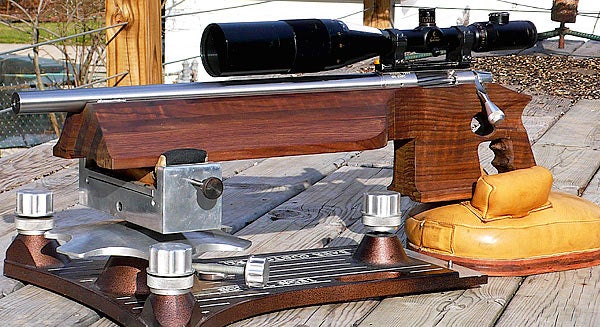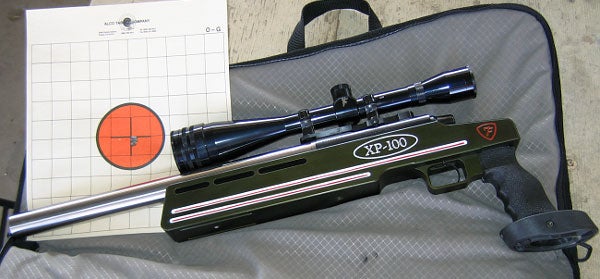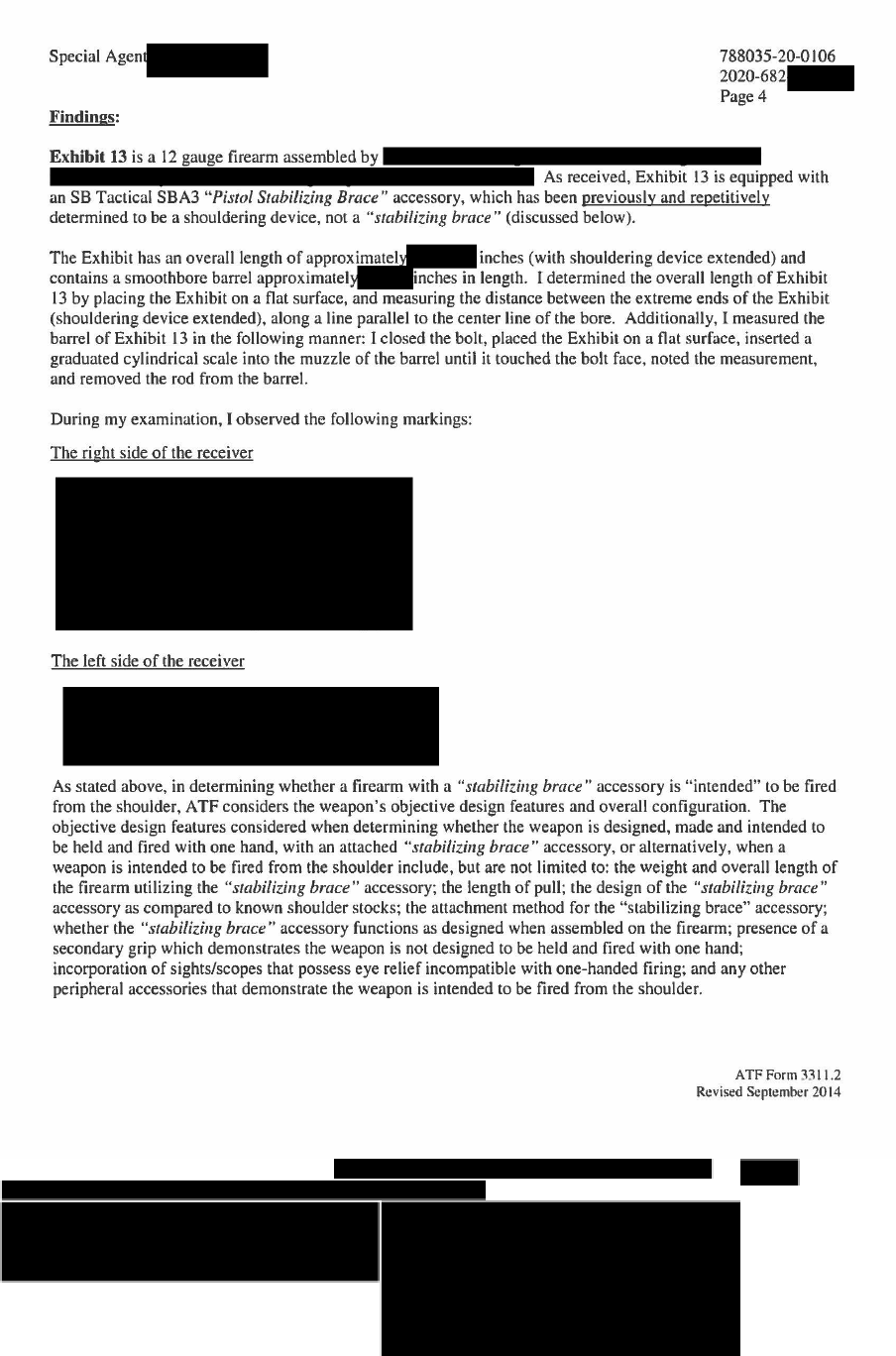An article popped up recently from Ammoland that alleges the ATF is singling out SB Tactical and their products. However, there may be a greater issue below the surface. The ATF seems to be re-evaluating previous determinations and contradicting information previously provided to manufacturers and consumers. Let us take a look at the problem and point out the fallacy of the ATF.
Stabilizing Braces Are NOT Shouldering Devices
Remember five years ago the infamous “Open Letter” regarding the shouldering of braces constitutes re-design? In 2017 the ATF sent a clarification letter addressed directly to SB Tactical that only addressed SB Tactical products. But as some have said, “a rising tide lifts all boats”. From then on a plethora of other companies tried their hand at making stabilizing braces. Some made of metal, some made of rigid plastic. Some made for Glocks, and others are modified stocks just with the butt removed and replaced with a brace of some fashion. All of which has never been evaluated by the ATF as well. While the Shockwave blade and Gear Head Works braces were submitted on firearms to the ATF, they were never evaluated on all the variant firearms and new configurations that are prevalent now.
Besides those simple facts, the ATF Firearm Technology Criminal Branch is making claims that are contradictory. For those of you who do not know, there are many different sides to the ATF. The “Tech Branch” is the office of agents that sit around and make determinations based on submissions. Firearms Technology Criminal Branch is a separate section that is used as experts in a criminal case when a firearm is used in a crime. The Criminal Branch will then evaluate the firearm and make their own determinations even when it contradicts Tech Branch and in some cases, themselves.
If you recall just over two years ago I posted about a case in Ohio where a guy was charged with making an illegal SBR because Criminal Branch wrongly determined his cheek rest was a stock. Refresh your memory here. There were a lot of inconsistencies in that case. They are contradicting previously established determinations and flat out measured LOP wrong and used that to claim the defendant made an SBR.
Then you have the infamous bump stock ban, which I may remind you they do not have legal authority for according to Ben’s article. To refresh your memory, read my analysis of the bump stock ban by the ATF.
Those examples are from the past and show a trend that the ATF contradicts themselves. Ammoland’s FOIA letter is dated September 2020. In this new Criminal Branch letter, there are a lot of inconsistencies. Let’s take a look at them. In the report below, the Special Agent is tasked to determine if the 12 ga firearm is a Short Barreled Shotgun.
ATF Contradicting Themselves, Again

On the first page, they quote GCA definitions of what constitutes a “firearm” and a “shotgun”. Then they quote the NFA definition of a short-barreled shotgun. What happens next is the part that is concerning.
On the third page, they talk about the “marketing” of the items as a component in their determination. Why is free speech to be considered with regards to determining the classification of a firearm? The report also talks about manufacturers and their marketing. The agent is talking about the firearm manufacturer here. Later, on page 5, the Special Agent brings up how SB Tactical markets their products. Again I question this line of inquiry on evaluating a firearm and how it measures up against an established set of parameters whether it is an NFA item or not. Clear guidelines would be great right about now.

The paragraph immediately after the list of objective design features talks about “this is far from the “incidental” use of an arm brace as a shouldering device“. Well, it seems this Special Agent has not read his or her own department letters and previous determinations. From the SB Tactical 2017 clarification letter, we find this section below.

Here is where reading comprehension is crucial. Many people have been caught up in this extremely long drawn out sentence. They see words like “incidental, sporadic and situational use.” However, if you pull back from looking at the bark of the tree and see the forest, this entire sentence is saying that their previous “interpretation” was wrong. The 2015 letter alleged that shouldering an arm brace equipped firearm near the shoulder constitute redesign, well they admitted later in 2017 that this is no longer the case. Shouldering a firearm with a brace does to make it an NFA item. And yet we have the Special Agent of Criminal Branch bringing up “incidental” and “shouldering” again in 2020.
Let’s go back and look at the “objective design features”.

Why would the caliber have any bearing on what constitutes a handgun or not? Long before there were stabilizing braces, people have made pistols that shoot rifle caliber bullets. Bench rest pistols are a thing. Also isn’t the Special Agent supposed to be focusing on a 12Ga firearm? What does it matter that it has a brace on it?

They mention length of pull and yet do not want to get caught having to make clear guidelines and throw in some random example of a Troy Tomahawk Short that has a LOP of 7″. Well, they should just throw LOP out of the window then since it clearly does not matter. Also, they are talking about a collapsing PDW stock. When fully collapsed that LOP is not even functional. MP5 collapsing braces have an extremely short LOP when collapsed. Doesn’t mean it is practical but what does that have to do with a brace? Nothing.
Now the Special Agent dives deeper into objective design features of stabilizing braces. Does it function like a “shouldering device”? Just because anything can be a shouldering device doesn’t make it so. The design compared to stock designs? So aesthetics is now a consideration? The MPX PDW brace was designed similarly to the MPX collapsing stock and it was approved. Other manufacturers’ braces have been approved even though they function more like a stock and look more like a stock.
How much rear contact surface area there is on a brace? Other than the shockwave blade and similar single blade like designs, most braces are wide to accept a shooter’s forearm so width seems arbitrary and useless here. Remember the original SB15 brace made for SIG Sauer? That thing was massive. So massive that people were putting adult accessories inside the arm cavity. The special agent even mentions the material used to make the stabilizing brace. Well, all of SB tactical braces are rubber straps. Some have metal and plastic for the attachment point and have been approved like the MPX PDW brace. While other braces from other manufacturers are made of more solid stock like materials.
Shared or interchangeable parts with known shoulder stocks is the part where someone took a stock, removed the butt pad and replaced it with a brace. This is not an SB Tactical issue since their braces are standalone products. Their methods of attachment are all unique designs that they made. There are other braces that utilize parts from stocks. Like converted CZ Scorpion stocks, ACR stocks, KRISS Vector stocks, etc, and people have removed the butt pad to replace it with a brace like a Tail Hook.
Presence of a secondary grip. This is extremely vague. It has to do with the design of the weapon not for one-handed use. Are we talking about vertical grips? AFGs? Barrel Shrouds? Handguards? Bipods? Let’s be clear here for once, ATF – that would be great.
They also mention the eye relief of optics. Don’t tell me how to shoot my gun. Scopes on pistols have been long since been established. How far away my eye is from the scope does not make my handgun into a rifle.

Installation of monopods/bipods or large capacity magazines is now criteria? What?? Bipods on handguns have been approved for decades.

The last “objective design feature” mentions large capacity magazines. What does it matter how much ammo I shove into a gun? Glocks can have a drum magazine, have I made an SBR now? This list of “objective design features” does not seem that “objective” to me. I am reminded of the Princess Bride.
“You keep using that word. I don’t think it means what you think it means“
Moving onto page 4.

I am unsure where this Special Agent got the notion that the SBA3 has been “previously and repetitively determined to be a shoulder device”. When and where did that happen? Then the Special Agent uses the “objective design features” to prove his point. And yet I already pointed out that this list is meaningless at establishing if an NFA item was made.
 On page 4, the Special Agent doubles down on the “marketing” of the brace and brings up some case in 2019 that alleges the SBA3 is a shouldering device. Well, there was a case in 2017, evaluated by Criminal Branch, about some firearms equipped with SB Tactical braces and all was fine. Take a look at the 2017 Criminal Branch report below.
On page 4, the Special Agent doubles down on the “marketing” of the brace and brings up some case in 2019 that alleges the SBA3 is a shouldering device. Well, there was a case in 2017, evaluated by Criminal Branch, about some firearms equipped with SB Tactical braces and all was fine. Take a look at the 2017 Criminal Branch report below.
https://www.scribd.com/document/485765841/ATF-approved-the-SB-Tactical-SOB-and-SBM4-in-2017
In that document, the Special Agent did not determine the braces made the guns into NFA items.


It was an SOB and SBM4 brace. Both have been approved by Special Agent Michael Walton to NOT be considered shouldering devices. Here is the important part. This is locked in stone now. Once the Criminal Branch established this in a case, they cannot go back and undo this. It sets a precedence and they have to adhere to it. And yet the Special Agent in 2020 ignores this established point in history. You cannot have one set of rules apply to one person and not apply to the other.
Just after the marketing angle on page 5, Special Agent mentions something on February 2019 regarding an SBA3 brace that was determined to be a shouldering device. According to sources, this was a modified brace and the case went nowhere. So why did this Special Agent bring this up to support his or her report?

On the last page, page 6, the Special Agent test fired the 12 ga firearm equipped with an SBA3 and claims that the brace did not stabilize the gun at all. Maybe he or she misused the SBA3 and is using that to come to an incorrect conclusion. The use of firearms is very subjective from one shooter to the other. Not everyone uses firearms the same way.
For years SB Tactical has been working with the ATF. They have held numerous meetings with the Tech Branch. In some cases, multiple times in a single month. They have been trying to get the ATF to establish hard guidelines and yet they refuse to do so. Go back and look at the “objective design features” list. It says “BUT NOT LIMITED TO” just before the list of crazy. Even here the Special Agent does not want to have clear established guidelines for the public to adhere to and follow. They leave room for future “interpretation”. Stop contradicting yourselves. It is hard enough to stay compliant when you make things up and move the goalposts. One day a bump stock is just a bump stock. Another day someone re-interprets the NFA and magically the bump stock is now a machine gun. Today it is stabilizing braces are somehow “shouldering devices” when clearly that is not the case.
 Your Privacy Choices
Your Privacy Choices
